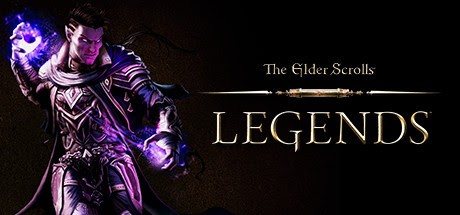The Elder Scrolls: Legends – Beginner’s Guide to Ranked Play

After the Story
By the time you finish the story, you will have some of the basic cards you can use throughout the game, although most of them will be novice. As you level up, these cards will upgrade into more useful versions of themselves.
Valenwood Trapper becomes Valenwood Huntsman
Whiterun Recruit becomes Whiterun Trooper
Hive Worker becomes Hive Defender or Hive Warrior
Snapping Dreugh becomes either Dreugh Shell Armor or Vicious Dreugh
Guild Recruit becomes either Thieves Guild Recruit or Fighters Guild Recruit
Camlorn Adventurer becomes either Camlorn Hero or Camlorn Sentinel
Archein Guerrilla becomes either Archein Venomtongue or Archein Elite
Divine Conviction becomes Divine Fervor
Quin’rawl Skulker becomes Quin’rawl Burgler
Rihad Nomad becomes either Rihad Battlemage or Rihad Horseman
Orc Clansman becomes either Orc Clan Shaman or Orc Clan Captain
Rotting Draugr becomes either Deadly Draugr or Deathless Draugr
Northpoint Lieutenant becomes Northpoint Captain
Stalking Crocodile becomes either Lurking Crocodile or Ravenous Crocodile
Dres Guard becomes either Dres Renegade or Dres Tormentor
Deshaan Sneak becomes Deshaan Avenger
Alik’r Bandit becomes Alik’r Survivalist
Reclusive Giant becomes Vigilant Giant
Dune Rogue becomes either Dune Smalker or Dune Smuggler
Detain becomes Imprison
Night Patrol becomes Night Predator or Night Shadow
Twilight Werebat becomes Moonlight Werebat
Slaughterfish becomes Slaughterfish Spawning
Rising Legate becomes Renowned Legate
Fate’s Witness becomes Fate Weaver
Student of Arms becomes Master of Arms
Wild Spriggan becomes Wild Beastcaller
Expert Atromancer becomes Supreme Atromancer
Winter’s Touch becomes Winter’s Grasp
Stronghold Prototype becomes Stronghold Eradicator or Stronghold Incubator
Cave Grahl becomes Angry Grahl
Starved Hunger becomes Ravenous Hunger
Volkihar Lord becomes either Blood Magic Lord or Night Talon Lord
As in the story, occasionally, you will have the option to choose which card you want. Even though both cards are useful, if you want to jump into ranked as quickly as possible, it’s better to choose cards that are more guaranteed, like Fighters Guild Recruit or Night Shadow. However, you should generally choose according to which cards you received from the early packs.
Building Your Collection for Ranked Play
Building your collection for ranked play is going to take some grinding or real money. Even if you buy packs, it’s better to play solo arena for a while before spending your gold in versus arena. After you finish each arena (win all the matches), you will rank up, the AI will be stronger (sometimes unfairly), and you will get better opponents in versus arena. If you decide to play versus arena, you usually end up with 1-2 wins and get 1 pack, whereas in solo you can get at least 4-5 wins with better rewards. So the best way to quickly understand the game mechanics and build your collection is by doing solo arenas. Next, we will discuss some basic tactics and deckbuilding.
Basic Deckbuilding / Tactics
With your basic cards in place, you need to decide what kind of gameplay suits you. Legends has some limitations against face/aggro with the rune/prophecy mechanic, but that doesn’t mean you can’t be aggressive. Control decks mainly use blue/green, while aggressive decks use red/purple. But you can mix and match colors to suit your playstyle. As your collection grows, you’ll see that every color has some cards to balance out their weaknesses. Yellow is, in my opinion, the most stable and useful color in difficult scenarios.
The most important thing to be aware of is board control. In Legends, any creature that stays on the board is a threat, especially with items and buffs. Occasionally, you’ll face red players with heavy hitters right off the start. Have some mass actions like Ice Storm, Fire Storm, Burn & Pillage, or Fireball, or single clears like Piercing Javelin and Lightning Bolt. Never use a deck without at least one or two STOP cards. If your opponents play a high-threat card like Quinrawl Burglar, Flesh Atronach, or Bog Lurcher (with 9 attack and 1 hp in the shadow lane) and you can’t put up a guard or destroy it, it will quickly drain your HP.
If you can control the board until turn 6-7, you’ll have the opportunity to make your plays. You might take some damage early, but as long as you don’t drop below 15 HP before mid-game, you can easily stage a comeback.
Face Hitting and Rune/Prophecy Mechanic
In Legends, the rune/prophecy mechanic activates at 25-20-15-10-5 health. Your opponent will draw a card, and if it’s a prophecy, they can play it on your turn with no cost. Be cautious when going for face hits—unless you have enough control or cards to maintain tempo, that prophecy might be a Piercing Javelin, and your buffed creature will be dust.
If you’re going for aggressive hits, don’t stop. Keep up the pressure. Your opponent can only hold 10 cards, so if you have a good early draw and keep hitting, they won’t have time to play their combos. Have some items and basic spells to keep your creatures alive, and you could see their life at 0 by turn 5-6.
More Advanced Tactics & Ranked Play
Now that you know the basics, it’s time to jump into ranked play.
You’ll start at rank 12 and aim to climb to rank 1 and legend. Until rank 10, losing matches won’t cost you stars. Every month, based on your milestone rank (9-5-1), you’ll receive 1-2-3 copies of a monthly reward card, some gold, and dust. These cards change each month and are sometimes highly valuable, like Sower of Revenge.
Up until rank 8-9, your opponents won’t be using many legendaries or unusual combos. At these ranks, prioritize killing early buffers like Legion Trainer or Brauma Armorer, or you’ll find yourself overwhelmed by low-cost buffed cards. Keep an eye out for constant supports like Divine Fervor or Thieves Den and elixirs that buff creatures temporarily. Always have a support killer like Vicious Dreugh in your deck as a precaution.
Another key consideration is buffing creatures with spells or items. You can annoy your opponents by buffing low-cost creatures and forcing them to use removals early. Alternatively, you can save buffs for a one-shot kill strategy, where you play a 6-7 damage creature and buff it to finish off your opponent. This can prevent them from drawing runes.
Board Control and Removal Tactics
I’ve mentioned mass removals already, and they’re crucial for board control. Blue decks, in particular, need Ice Storm, Firebolts (which can be obtained via Cunning Ally, though with some RNG), and Winter’s Grasp. You can also use Dres Tormentor to combo with Winter’s Grasp for extra damage.
For green, wound mechanics are essential. Cards like Finish Off and Leaflurker can kill any creature that’s wounded, regardless of HP. When paired with red’s “deal 1 damage” cards, this becomes an effective board control tactic. Yellow provides powerful single-target removals like Piercing Javelin and Sanctuary Raid. Red doesn’t have straightforward removals but compensates with hard-hitting creatures. Its ace, Unstoppable Rage, can clear an entire lane when used on a breakthrough or drain creature, making it a powerful (and likely to be nerfed) option.
Now that you’re prepared, let’s jump into more advanced combos and tactics!






